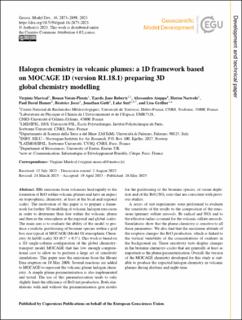| dc.contributor.author | Marécal, Virginie | |
| dc.contributor.author | Voisin-Plessis, Ronan | |
| dc.contributor.author | Roberts, Tarda Jane | |
| dc.contributor.author | Aiuppa, Alessandro | |
| dc.contributor.author | Narivelo, Herizo | |
| dc.contributor.author | Hamer, Paul David | |
| dc.contributor.author | Josse, Beatrice | |
| dc.contributor.author | Guth, Jonathan | |
| dc.contributor.author | Surl, Luke | |
| dc.date.accessioned | 2023-06-07T10:49:52Z | |
| dc.date.available | 2023-06-07T10:49:52Z | |
| dc.date.created | 2023-05-31T09:08:52Z | |
| dc.date.issued | 2023 | |
| dc.identifier.citation | Geoscientific Model Development. 2023, 16, 2873-2898. | en_US |
| dc.identifier.issn | 1991-959X | |
| dc.identifier.uri | https://hdl.handle.net/11250/3070334 | |
| dc.description.abstract | HBr emissions from volcanoes lead rapidly to the formation of BrO within volcanic plumes and have an impact on tropospheric chemistry, at least at the local and regional scales. The motivation of this paper is to prepare a framework for further 3D modelling of volcanic halogen emissions in order to determine their fate within the volcanic plume and then in the atmosphere at the regional and global scales. The main aim is to evaluate the ability of the model to produce a realistic partitioning of bromine species within a grid box size typical of MOCAGE (Model Of atmospheric Chemistry At larGE scale) 3D (0.5∘ × 0.5∘). This work is based on a 1D single-column configuration of the global chemistry-transport model MOCAGE that has low enough computational cost to allow us to perform a large set of sensitivity simulations. This paper uses the emissions from the Mount Etna eruption on 10 May 2008. Several reactions are added to MOCAGE to represent the volcanic plume halogen chemistry. A simple plume parameterisation is also implemented and tested. The use of this parameterisation tends to only slightly limit the efficiency of BrO net production. Both simulations with and without the parameterisation give results for the partitioning of the bromine species, of ozone depletion and of the ratio that are consistent with previous studies. A series of test experiments were performed to evaluate the sensitivity of the results to the composition of the emissions (primary sulfate aerosols, Br radical and NO) and to the effective radius assumed for the volcanic sulfate aerosols. Simulations show that the plume chemistry is sensitive to all these parameters. We also find that the maximum altitude of the eruption changes the BrO production, which is linked to the vertical variability of the concentrations of oxidants in the background air. These sensitivity tests display changes in the bromine chemistry cycles that are generally at least as important as the plume parameterisation. Overall, the version of the MOCAGE chemistry developed for this study is suitable to produce the expected halogen chemistry in volcanic plumes during daytime and night-time. | en_US |
| dc.language.iso | eng | en_US |
| dc.rights | Navngivelse 4.0 Internasjonal | * |
| dc.rights.uri | http://creativecommons.org/licenses/by/4.0/deed.no | * |
| dc.title | Halogen chemistry in volcanic plumes: a 1D framework based on MOCAGE 1D (version R1.18.1) preparing 3D global chemistry modelling | en_US |
| dc.title.alternative | Halogen chemistry in volcanic plumes: a 1D framework based on MOCAGE 1D (version R1.18.1) preparing 3D global chemistry modelling | en_US |
| dc.type | Peer reviewed | en_US |
| dc.type | Journal article | en_US |
| dc.description.version | publishedVersion | en_US |
| dc.rights.holder | © Author(s) 2023. | en_US |
| dc.source.pagenumber | 2873-2898 | en_US |
| dc.source.volume | 16 | en_US |
| dc.source.journal | Geoscientific Model Development | en_US |
| dc.identifier.doi | 10.5194/gmd-16-2873-2023 | |
| dc.identifier.cristin | 2150347 | |
| cristin.ispublished | true | |
| cristin.fulltext | original | |
| cristin.qualitycode | 2 | |

